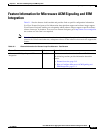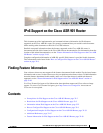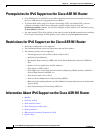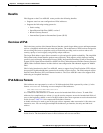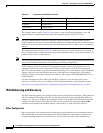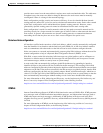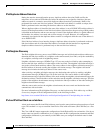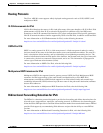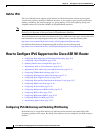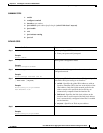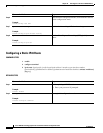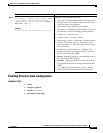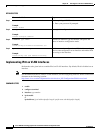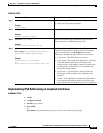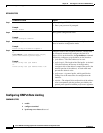
32-7
Cisco ASR 901 Series Aggregation Services Router Software Configuration Guide
OL-23826-09
Chapter 32 IPv6 Support on the Cisco ASR 901 Router
Information About IPv6 Support on the Cisco ASR 901 Router
Routing Protocols
The Cisco ASR 901 router supports widely deployed routing protocols such as IS-IS, OSPFv3, and
multiprotocol BGP.
IS-IS Enhancements for IPv6
IS-IS in IPv6 functions the same as in IPv4 and offers many of the same benefits as IS-IS in IPv4. IPv6
enhancements to IS-IS allow IS-IS to advertise IPv6 prefixes in addition to IPv4 and OSI routes.
Extensions to the IS-IS command-line interface (CLI) allow configuration of IPv6-specific parameters.
IPv6 IS-IS extends the address families supported by IS-IS to include IPv6, in addition to OSI and IPv4.
For more information on IS-IS Enhancements for IPv6, see the following document:
http://www.cisco.com/en/US/docs/ios-xml/ios/ipv6/configuration/15-2mt/ip6-is-is.html
OSPFv3 for IPv6
OSPF is a routing protocol for IP. It is a link-state protocol. A link-state protocol makes its routing
decisions based on the states of the links that connect source and destination machines. The state of a
link is a description of that interface, and its relationship to its neighboring networking devices. The
interface information includes the IPv6 prefix of the interface, the network mask, the type of network it
is connected to, the devices connected to that network, and so on. This information is propagated in
various type of link-state advertisements (LSAs).
For more information on OSPFv3 for IPv6, refer the following link:
http://www.cisco.com/en/US/docs/ios-xml/ios/ipv6/configuration/15-2mt/ip6-ospf.html
Multiprotocol BGP Extensions for IPv6
Multiprotocol BGP is the supported exterior gateway protocol (EGP) for IPv6. Multiprotocol BGP
extensions for IPv6 support many of the same features and functionality as IPv4 BGP. IPv6
enhancements to multiprotocol BGP include support for an IPv6 address family and network layer
reachability information (NLRI) and next hop (the next router in the path to the destination) attributes
that use IPv6 addresses.
For more information on Multiprotocol BGP Extensions for IPv6, refer the following link:
http://www.cisco.com/en/US/docs/ios-xml/ios/ipv6/configuration/15-2mt/ip6-mptcl-bgp.html
Bidirectional Forwarding Detection for IPv6
The BFDv6 is a detection protocol designed to provide fast forwarding path failure detection times for
all media types, encapsulations, topologies, and routing protocols. In addition to fast forwarding path
failure detection, BFD provides a consistent failure detection method for network administrators. BFDv6
provides IPv6 support by accommodating IPv6 addresses and provides the ability to create BFDv6
sessions.
For more information on Bidirectional Forwarding Detection for IPv6, refer the following link:
http://www.cisco.com/en/US/docs/ios-xml/ios/ipv6/configuration/15-2mt/ip6-bfd.html



